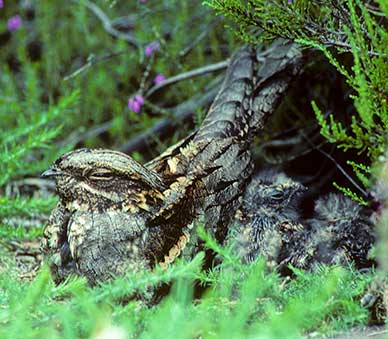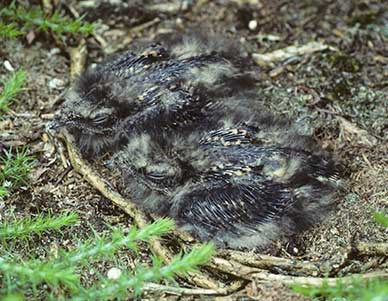Nightjar (Caprimulgus europaeus)
When: From mid-May to September
How many: Moderate numbers

Spring and summer visitors to Britain, nightjars usually arrive in the New Forest in the second or third week of May from African wintering grounds, and begin the return journey in late-summer.
In the New Forest, nightjars are essentially heathland birds, although some choose to breed in newly felled or regenerating woodland.
Distinctive, idiosyncratic creatures about the size of a blackbird, nightjars’ long, slender body and lengthy, narrow wings give them the look of a falcon in flight, whilst on the ground nightjars can appear eerily reptilian.
Strictly nocturnal creatures, nightjars take to the wing shortly after sunset, and spend much of the night hawking for insects - moths and dor beetles are favourites. Nightjars can be heard at dusk, dawn and intermittently through the night as the males advertise presence with a far-carrying sound usually described as ‘churring’.
Likened to the noise of a two-stroke motor cycle engine, the source of the sound is often incredibly difficult to locate as these skilled ventriloquists throw their voices off into the darkness, first in one direction, and then in another.
And when not ‘churring’, flight calls, most often given by the male nightjars, are equally distinctive – coo-ic, coo-ic, coo-ic – and so is the sound of wing-clapping displays.
Flight is buoyant and often seemingly erratic, at times similar to that of a kestrel, at other times almost tern-like, and whilst the bill is relatively small, the gape is enormous - it opens almost from cheek to cheek - and allows nightjars to quite literally trawl the skies.
Incubating or brooding nightjars spend the hours of daylight at the nest, a rather grand term for what is usually no more than a shallow scrape on a bed of moss or leaf litter. Edges of bracken patches are often used and so are gaps in the heather. Wonderfully camouflaged, mottled grey-brown plumage provides superb concealment.
Nightjars lay two white, irregularly marked eggs that hatch after 17-18 days to release tiny, down-covered nestlings. In fact, so covered in down are the newly hatched nightjar youngsters that it's often difficult to tell beak from tail.
But feathers quickly start to grow, and the rapidly developing chicks soon become quite mobile, able to wander about the immediate vicinity of the nest area where they seek shelter from the heat of the sun in adjacent patches of heather or bracken.
Radio tagging has shown that nightjars make foraging trips to feeding areas away from the nest, and consequently it's not unusual to hear them calling in flight above the canopy of the New Forest’s broad-leaved woodlands. Then late in the season, family parties of nightjars can sometimes be seen hawking along woodland rides in groups of three or four, maintaining contact until the youngsters gain sufficient confidence and competence to look after themselves.
John Wise, writing of the nightjar in the mid-19th century, noted the use of local, New Forest names for the bird, saying: ‘Known throughout the New Forest as the Night Hawk, Night Crow and Ground Hawk, from its habits, and manner of flying.’
Now, after many years of decline culminating in classification as a species of high conservation concern, nightjar numbers, assisted by successful habitat management initiatives, have recently increased.

A 2004 nightjar survey, organised jointly by the British Trust for Ornithology (BTO), the RSPB, English Nature and the Forestry Commission, revealed a national population of just over 4,000 ‘churring’ males. And whilst that is a relatively modest total, it does show an increase of 34% on the results of a similar survey organised in 1992. Here in the New Forest, the survey revealed that nightjar numbers had increased from around 330 ‘churring’ males to at least 567, an impressive jump of 74%.
Subsequently, a further survey, jointly funded by the New Forest National Park Authority, the Forestry Commission and the New Forest Verderers, undertaken during 2013 confirmed that New Forest nightjars continue to thrive and that the area is indeed a stronghold for these mystical creatures - preliminary results reveal that almost 550 male nightjars were detected during their spring and summer breeding season stay in the Forest.
So for now, these mysterious birds are doing rather well, and long may that continue.
References:
The Shell Guide to the Birds of Britain and Ireland: James Ferguson-Lees, Ian Willis and J.T.R. Sharrock
Hampshire Bird Reports: Hampshire Ornithological Society
The Birds of the Western Palearctic, Concise Edition: D.W. Snow and C.M. Perrins
The New Forest: Its History and Scenery: John R. Wise
More links
Other related links
Search this site

Sadly, 58 animals were killed - 35 ponies, 13 cows, 8 donkeys and 2 sheep, whilst a further 32 were injured - 3 pigs, 9 donkeys, 11 cows and 9 ponies.
(Forty-three accidents occurred in daylight, 15 at twilight and 101 in the dark. Twenty-seven accidents were not reported by the driver involved).
Here's just one horrific example - Three donkeys killed in collision with van at notorious New Forest blackspot (Advertiser and Times)

